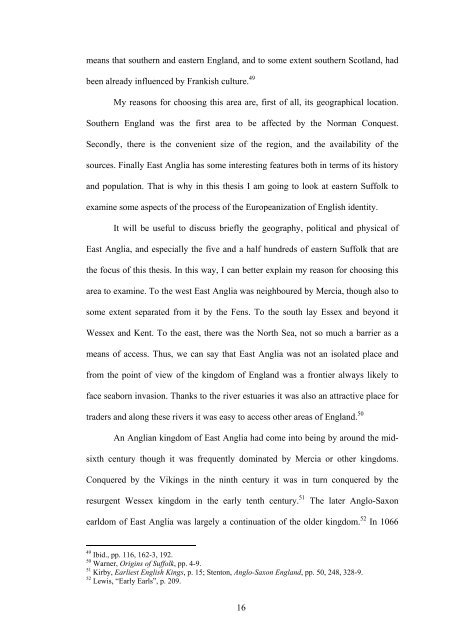I certify that I have read this thesis and have ... - Bilkent University
I certify that I have read this thesis and have ... - Bilkent University
I certify that I have read this thesis and have ... - Bilkent University
You also want an ePaper? Increase the reach of your titles
YUMPU automatically turns print PDFs into web optimized ePapers that Google loves.
means <strong>that</strong> southern <strong>and</strong> eastern Engl<strong>and</strong>, <strong>and</strong> to some extent southern Scotl<strong>and</strong>, had<br />
been al<strong>read</strong>y influenced by Frankish culture. 49<br />
My reasons for choosing <strong>this</strong> area are, first of all, its geographical location.<br />
Southern Engl<strong>and</strong> was the first area to be affected by the Norman Conquest.<br />
Secondly, there is the convenient size of the region, <strong>and</strong> the availability of the<br />
sources. Finally East Anglia has some interesting features both in terms of its history<br />
<strong>and</strong> population. That is why in <strong>this</strong> <strong>thesis</strong> I am going to look at eastern Suffolk to<br />
examine some aspects of the process of the Europeanization of English identity.<br />
It will be useful to discuss briefly the geography, political <strong>and</strong> physical of<br />
East Anglia, <strong>and</strong> especially the five <strong>and</strong> a half hundreds of eastern Suffolk <strong>that</strong> are<br />
the focus of <strong>this</strong> <strong>thesis</strong>. In <strong>this</strong> way, I can better explain my reason for choosing <strong>this</strong><br />
area to examine. To the west East Anglia was neighboured by Mercia, though also to<br />
some extent separated from it by the Fens. To the south lay Essex <strong>and</strong> beyond it<br />
Wessex <strong>and</strong> Kent. To the east, there was the North Sea, not so much a barrier as a<br />
means of access. Thus, we can say <strong>that</strong> East Anglia was not an isolated place <strong>and</strong><br />
from the point of view of the kingdom of Engl<strong>and</strong> was a frontier always likely to<br />
face seaborn invasion. Thanks to the river estuaries it was also an attractive place for<br />
traders <strong>and</strong> along these rivers it was easy to access other areas of Engl<strong>and</strong>. 50<br />
An Anglian kingdom of East Anglia had come into being by around the mid-<br />
sixth century though it was frequently dominated by Mercia or other kingdoms.<br />
Conquered by the Vikings in the ninth century it was in turn conquered by the<br />
resurgent Wessex kingdom in the early tenth century. 51 The later Anglo-Saxon<br />
earldom of East Anglia was largely a continuation of the older kingdom. 52 In 1066<br />
49 Ibid., pp. 116, 162-3, 192.<br />
50 Warner, Origins of Suffolk, pp. 4-9.<br />
51 Kirby, Earliest English Kings, p. 15; Stenton, Anglo-Saxon Engl<strong>and</strong>, pp. 50, 248, 328-9.<br />
52 Lewis, “Early Earls”, p. 209.<br />
16
















